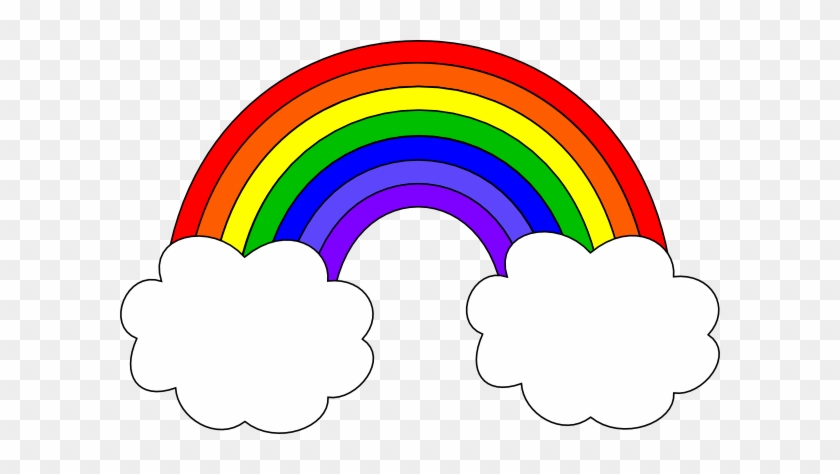Have you ever stopped to truly admire a rainbow after a storm? Those vibrant arches of color, stretching across the heavens, are a sight that inspires wonder and awe in all who see them. But have you ever wondered, how many colors actually are there in a rainbow?

Image: www.clipartmax.com
We all learned as children that there are seven colors in a rainbow: red, orange, yellow, green, blue, indigo, and violet. But is that really the whole story? Is there more to be discovered beyond the ROYGBIV acronym we memorized in school? Let’s dive in and explore the fascinating science behind rainbows and the spectrum of colors they reveal.
A Spectrum of Understanding
The colors we see in a rainbow are actually a result of sunlight being refracted, or bent, as it passes through water droplets in the atmosphere. This bending of light causes different wavelengths of light to be separated, revealing the full spectrum of visible light. While we typically perceive seven distinct colors, the reality is that the spectrum of visible light is continuous, with one color seamlessly blending into the next.
The number “seven” originates from Isaac Newton’s observations. He famously identified seven distinct colors in the visible spectrum, drawing parallels to the seven musical notes on the diatonic scale. This connection, while intriguing, is primarily based on human perception and the limitations of our eyes.
Beyond ROYGBIV: Finding More Hues in the Rainbow
While ROYGBIV serves as a useful mnemonic device, it’s important to understand that the colors in a rainbow aren’t rigidly defined. In fact, the boundaries between colors are fluid, and the number of colors we distinguish is influenced by factors like light intensity, personal perception, and cultural interpretations. Additionally, the human eye perceives a much wider range of colors than just those found in a rainbow.
Even the seemingly simple colors we learn as children, like blue, can encompass a vast array of shades. Think about the difference between the azure sky and the deep indigo of a stormy night. The spectrum of blue is far more nuanced than what we might initially grasp.
So, how can we reconcile the “seven colors” with the vastness of the real spectrum? It’s helpful to think about the rainbow as a gradual gradient, with each individual color representing a range of hues within that category. While we may assign a name to a general color, it’s crucial to remember that there exists an infinite spectrum of possibilities within each one.
The Art of Perception: What We See and What We Know
The perception of colors in a rainbow is a complex process. Our brains play a significant role in interpreting the information received by our eyes. Factors like lighting conditions, background contrast, and even our personal experiences can influence how we perceive colors.
What one person sees as a bright green may appear slightly more yellow to another. These individual variations are a testament to the subjective nature of color perception, reminding us that the “truth” of a rainbow’s colors is ultimately a matter of individual experience.

Image: www.fity.club
Rainbow Variations: The Beauty of Nature’s Canvas
The colors we see in a rainbow can also vary depending on the angle at which we view it and the environmental conditions. A double rainbow, for instance, displays a secondary arc with reversed colors, adding to the inherent mystique of this natural phenomenon.
The intensity and visibility of the rainbow are further influenced by factors like the size and distribution of water droplets, the angle of incoming sunlight, and even atmospheric pollutants. This dynamic interplay of elements creates a constantly evolving spectrum of colors, making each rainbow a unique and fleeting masterpiece.
Rainbow Colors in Our Daily Lives
Beyond simply being a breathtaking sight, rainbows hold significance in various aspects of our lives. They symbolize hope, new beginnings, and the spectrum of diversity that exists in the world. Their vibrant hues inspire artists, designers, and scientists, influencing our creativity and pushing the boundaries of our understanding.
Even in technology, the principle of light refraction and the spectrum of colors are applied in various ways, from the lenses in our eyeglasses to the screens on our digital devices. The colors that inspire our imaginations have tangible applications in the world around us, showcasing the interconnectedness of science, art, and our daily experiences.
How Many Colors Are There In The Rainbow
Conclusion: Embracing the Spectrum of Wonder
So, how many colors are there in a rainbow? The answer is not as simple as we might think. While we may learn to identify seven distinct colors, the reality is that the spectrum of visible light is continuous, and the number of colors we perceive is influenced by a multitude of factors, including our own unique perception.
The beauty of the rainbow lies not just in the colors themselves but in the endless possibilities and the profound connection they offer to the natural world around us. Let us embrace the diverse spectrum of colors, celebrating the wonders of the universe and appreciating the individual perspective we each hold. Go out and witness the magic of a rainbow, capturing its fleeting beauty and embracing the wonder it inspires.






